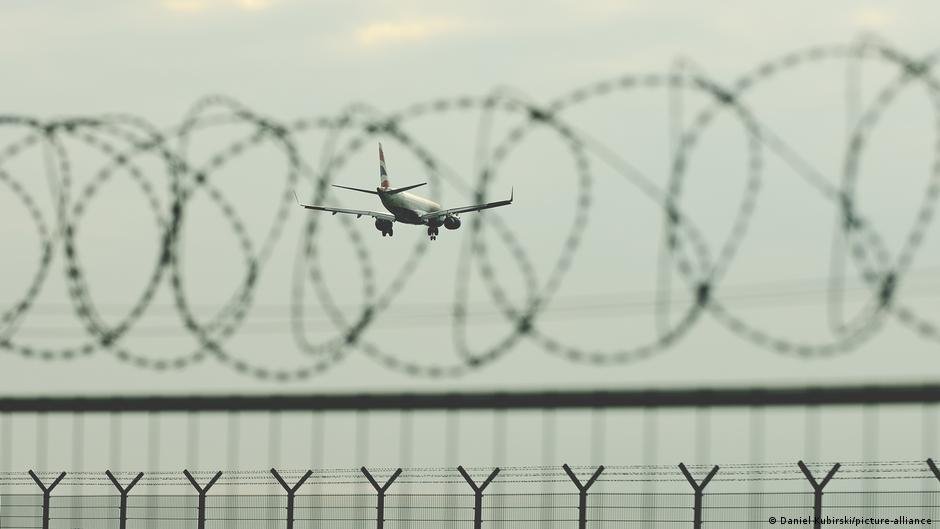The government of Bosnia and Herzegovina announced it was beginning to deport migrants back to their home countries. The measure began on Sunday with a test case of two Pakistani nationals on a commercial flight.
On Sunday, July 31, two Pakistani nationals were sent back to Islamabad on a commercial flight. Their deportation, said the Bosnian government, was being used as a "test case," with the hope that soon the country could start chartering planes and deporting thousands more.
The flight was reported by the local English language news portal Balkan Insight. A spokesperson for Bosnia’s security ministry confirmed that the two had been flown to Pakistan on Sunday.
"Commercial flight rules say that only two persons per flight can be deported, so we are counting in the future on having charter flights for bigger groups," spokesperson Admir Malagic told Balkan Insight.
Agreement with Pakistan signed in 2020
Bosnia and Herzegovina (BiH) has been wanting to deport migrants who do not qualify for, or do not ask for asylum since 2020 when it signed an agreement with Pakistan. Prior to the agreement, BiH had complained that Pakistan was refusing to work with its authorities on the thousands of migrants who had entered BiH without papers and were hoping to continue on from Bosnia into the EU and Western Europe.
In April 2020, Bosnia’s security minister at the time, Fahrudin Radoncic, ordered the country’s Service for Foreigners' Affairs SFA to compile a list with an estimated 9,000-10,000 migrants who were scheduled for deportation, because they were in BiH without the correct papers or visas. The list would have encompassed most Pakistanis, at the time around 3,000 reported Balkan Insight, in the country but excluded those coming from Syria.
A dispute ensued between Sarajevo and Islamabad, with Radoncic demanding that the Pakistani ambassador to Sarajevo "be declared persona non grata." After making this demand, Radoncic resigned in June, after failing to receive support from BiH’s presidency chairman or its foreign minister at the time.

More deportations planned
Back in 2020, the director of Bosnia’s SFA told Balkan Insight that "establishing the identity of migrants had been a problem for years because the embassies of countries where migrants come from do not want to cooperate."
However, two years later, it seems that the Bosnia authorities hope they might have started to get those countries on board. According to Balkan Insight, which quotes figures from the security ministry, between January and July 2022 9,329 migrants entered BiH.
🎧 Subscribe to Tales from the Border, and listen to previous episodes along the Balkan Route here.
InfoMigrants contacted the Bosnian Ministry for Security, which manages immigration and asylum policy in BiH, and regulates procedures in regard to movement and stay of foreigners in the country. We asked them how many migrants in total they were hoping to deport and back to which countries. We have not yet received a response from them.
About 2,133 migrants are resident in official reception centers which are currently being run by the UN Migration Agency IOM in Bosnia. Pakistani citizens make up about 13% of the camp inmates, reports Balkan Insight.
Reception centers in Bosnia and Herzegovina
There are six official reception centers in BiH, operated by UNHCR and IOM. According to the websites, there is limited accommodation and essential and basic services available there for those seeking asylum. There are two centers reserved for those wanting to seek asylum, in Trnovo and Mostar. Then four more temporary centers, two in Sarajevo Canton and two in Una-Sana Canton, which are split between a center predominantly for single men in each location and a center predominantly for women and families and unaccompanied minors.
According to the UN refugee agency's latest figures updated on June 30, the number of refugees, asylum seekers and other people traveling as, or part of mixed movements in BiH was 2,513. Across the entire Balkan route, comprising Serbia and Kosovo, BiH, Albania, Montenegro and North Macedonia, 9,385 people were registered.
Often, migrants will wait in one country for a few months, if not years, before attempting to cross the border into the next. Their journeys are often not linear. Many migrants who have spoken to InfoMigrants over the years have recounted being pushed back numerous times, sometimes to countries they had previously not even been present in. So, someone for instance might arrive in Hungary or Romania, via a third country and be sent back to Serbia, or from Serbia to Bosnia, before re-crossing that border.
Back and forth along the 'Balkan route'
According to UNHCR, the majority of the current migrant population along the Balkan route is made up by those of unspecified nationality, closely followed by Afghans, accounting for 21,9% of those traveling, Syrians accounting for 13.4% and Pakistanis, accounting for 9.9%. Other South Asians, from Bangladesh and India make up just over 10% together.
In June 2022, UNHCR figures showed that the numbers of migrants and asylum seekers entering BiH irregulaly had increased by 13% over arrivals in May 2022 and had increased 23% on the numbers that arrived a year previously, in June 2021.
According to UNHCR, since January 2018, a total of 93,341 migrants have been recorded in BiH. Interestingly, in June, 2, 159 people expressed their intention to seek asylum in Bosnia, the majority of those were from Bangladesh 31%, Afghanistan 22%, Burundi 17% and Pakistan 8%. However, just seven decisions were issued in June and just two people were granted subsidiary protection, whereas five received negative responses.
The UNHCR noted that most asylum seekers wait an average of 295 days for their asylum request to receive a first-instance decision.
